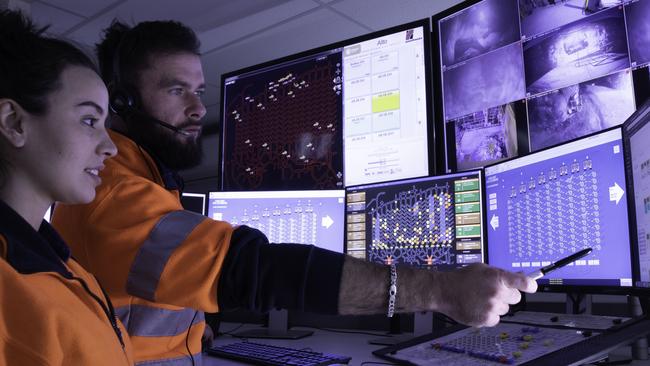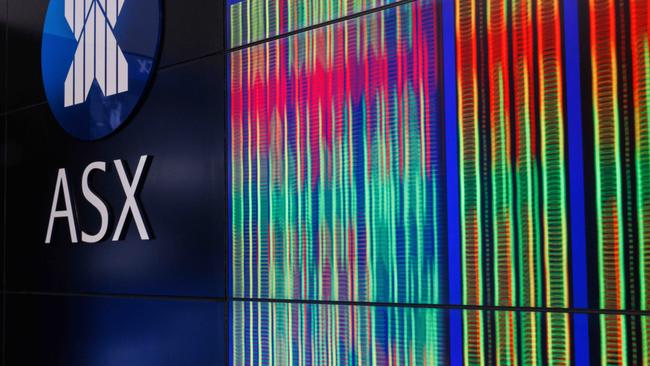Newmont, Newcrest merger: Why copper is becoming the new gold standard
It was Newcrest’s copper-rich gold mines that gave it the extra shine as the US mining giant Newmont circled.
Business
Don't miss out on the headlines from Business. Followed categories will be added to My News.
There’s more to the world’s biggest gold acquisition than glitters, as copper fast becomes the new precious metal.
The Denver, Colorado-based Newmont had been studying Melbourne’s last remaining big gold mining property for years but it was Newcrest’s copper-rich gold mines that gave it the extra shine.
The $26.2bn all-share deal came together in just three months since it was first floated in February. Newmont went back in April to get things moving by topping-up the offer with the final pricing holding to the final agreement that was signed by Newcrest’s board over the weekend.
Newmont’s Australian-born and Monash University-educated chief executive Tom Palmer is a fourth generation miner and spends several months of the year in Perth near his company’s Boddington mine. The location has helped him to also keep watch on Australia’s biggest standalone gold miner, including its temperamental but strategically important Lihir mine in Papua New Guinea.

For Palmer it was the prospect of getting even bigger in copper that helped sweeten the deal to his own shareholders.
Two acquisitions in recent years, including the $US10bn ($15bn) acquisition of Canada’s Goldcorp four years ago, has already substantially boosted Newmont’s copper exposure. Today the US giant looks more like a base metals business than a pure gold play.
“If we’ve got an opportunity to get further exposure to copper – we’ve got a pretty healthy portfolio of copper today in terms of projects and operating size – but a growing exposure for copper is important to us,” Palmer says.
Here he is betting on copper for the central role the metal is set to play in the energy transition, with the metal an essential ingredient for electric vehicles and renewable energy hardware from windmills to batteries. BHP last month signed off on its $9.6bn buyout of copper producer OZ Minerals for the same strategic themes.
Palmer says it is “inevitable” that the run on copper will go on with the metal to be in strong demand for a long time. The two metals – gold and copper – generally move in the same direction but together Palmer believes will give Newmont a portfolio that is resilient for most cycles.
“If you’re mining copper, you’re going to be getting gold. If you’re mining long life gold deposits, you’re going to be getting copper, they come together,” he says.
The Newmont boss was speaking to The Australian from Barcelona where he was preparing to present at the Bank of America metals and mining conference this week. Rio Tinto boss Jakob Stausholm and BHP’s Mike Henry are also appearing at the conference from Tuesday.
Tier one mines
Palmer, who was born in Broken Hill, says that following the transaction Newmont will have 10 tier-one and long-life mines around the world including in Australia. In total the merged company will produce 8 million ounces of gold annually, with two-thirds of that coming from the top 10 mines.
While Newmont has its hands full with the Newcrest merger, pressure will remain for more M&A across the gold mining industry, particularly as investors put greater pressure on gold miners to hit net zero targets.

“There are in order of magnitude more publicly listed gold companies than any other commodity in the mining game. To get access to capital or the need to have long life mines to support the energy transition to make net zero targets, this will require a consolidation in the gold industry.”
The merger has been signed off with gold again nudging near record high prices, trading above $US2000 an ounce, as markets bet that high inflation will remain for longer. Palmer acknowledges that gold is having its moment in the sun but gold can be highly cyclical.
“If you only go back six months or so ago, gold was in the $US1600s,” he says. “We’ve obviously seen pressures on input costs for mining companies and many other companies around the world. And we’ve seen downside pressure on gold in more recent times. So we take a fairly sober view, when it comes to the gold price”.
Indeed Palmer builds his mines around an assumption of a $US1400 gold price so he can keep profitable through the swings. Many of Newcrest’s operations are lower than that.
Palmer says Newmont has a lot of experience in integration through the acquisition of Goldcorp. That deal generated $1bn in additional cashflows. Once the Australian acquisition is finalised Newmont will push ahead with the review of Newcrest’s portfolio and expansion plans – some of these are likely to be put on hold. In Newcrest, which has ultra-low cost mines, Palmer is targeting some $2bn in additional cashflows over coming years from bringing the two companies together.
The merger agreement saw the two settle on a ratio of 0.4 Newmont shares per Newcrest share. The combined company will be 69 per cent owned by Newmont with the balance going to Newcrest shareholders. Newcrest shareholders will also get a $1.10 special dividend, funds that would have otherwise been set aside for mine development costs.
Since the sudden exit of dominant CEO Sandeep Biswas last December, Newcrest has been running smoothly but in a strategic holding pattern, making it a sitting target for an acquisition. The miner has been searching for a new CEO, while finance chief and acting chief executive Sherry Duhe has been running the company, but recruitment has been complicated by the merger approach.
No big deal
An agreement to get the world’s biggest gold acquisition away has fired up what has been the sluggish start to dealmaking this year.
Indeed, the Newmont mega move on Newcrest as well as Origin Energy’s revised $18.2bn offer earlier this year makes up more than have the deal transactions in the calendar year-to-date.
A sweetened $1.9bn InvoCare tabled earlier Monday and the $15bn Allkem-Livent merger announced on Friday give the impression of a wave of deal activity, but it has been a long time coming.
So far this calendar year, there has been $US63.1bn of announced mergers involving Australian target or buyer, according to Bloomberg figures. This is down from $70.2bn for the same period a year earlier, and is flat on the first two quarters of the 2021 financial year. Strip out the Origin offer which was first tabled last November, and Australian deal making hits the lowest level since the depths of the global pandemic when most companies were in survival mode.

Mining has been the hottest sector over the past year, given a commodities boom and low levels of debt means many companies are sitting on high levels of cashflow. Inflated share prices are helping to underpin currencies.
Fresh from its mega oil merger with Woodside, BHP last year got the ball rolling on its $9.6bn OZ Minerals buyout. While Australia’s emerging lithium producer Liontown has knocked back a $5.2bn offer from US producer Albemarle. Rio Tinto secured a pre-Christmas deal to buy Canada’s Turquoise Hill for $3,3bn, although that was a matter of much-needed housekeeping to clean up its copper holdings. Last week, Silver Lake upped its $707m cash and share offer for St Barbara.
Uncertainty on how far the US Federal Reserve will go in rate hikes to curb inflation – a move that will hurt share values – has been putting deal activity on hold. At the same time, surging borrowing costs has made prospective buyers wary about financing just as the global economy is set to fall into a recession. At the same time, the IPO market, another lucrative income stream for bankers, has dried up. The Virgin Australia offer slated for the end of this year will be closely watched.
Wall Street banks from Goldman Sachs, Morgan Stanley and Bank of America (previously known as Merrill Lynch) have already announced global job cuts amid the downturn. The fire sale buyout of Credit Suisse buyout of UBS is also expected to result in a further jobs shake-out.
Dealmaking moves in cycles, with boards more likely to hit the pause button on transactions until the right time emerges rather than abandon activity all together.
johnstone@theaustralian.com.au
More Coverage
Originally published as Newmont, Newcrest merger: Why copper is becoming the new gold standard





